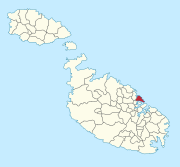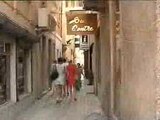Sliema
| coat of arms | map |
|---|---|

|
|
| Basic data | |
| State : | Malta |
| Gzejjer : | Malta Majjistral (Northwest Malta) |
| Distretti : | Northern Harbor |
| Area : | 1,295,996 km² |
| Residents : | 22,591 (December 31, 2018) |
| Population density : | 17,431 inhabitants / km² |
| ISO 3166-2 : | MT-56 |
| Postal code : | SLM |
| Website : | http://sliemalocalcouncil.com/ |
| politics | |
| Mayor : | Johanna Gonzi ( PN ) |
Coordinates: 35 ° 55 ' N , 14 ° 30' E
Sliema (Tas-Sliema) is a city on the northeast coast of the island of Malta with many shops, restaurants, hotels and a big city atmosphere and an important commercial and residential area. Sliema, which means peace, was once a very quiet fishing village on a peninsula across from Valletta . Today Sliema and St. Julian's up the coast are Malta's most important seaside vacation spots, especially for language travelers and, because of the mild winter climate, also for older tourists.
There are five military installations on the coast: St. Julian's Tower from the 17th century, Fort Sliema from around 1880, Cambridge Battery , Garden Battery and Fort Tigne from 1760, across from Fort St Elmo . Numerous excursion boats and a ferry to Valletta depart from the port. The German Embassy is located on Tower Road.
The influence of the British
English is the main language spoken in Sliema , which distinguishes it from all other villages and towns in Malta. The use of English eventually spread to the neighboring towns of Swieqi and St. Julian's as well as to more upscale areas such as Attard and Balzan . Sliema has a considerable number of streets named after British governors or places such as: B. Norfolk Street, Prince of Wales Road (which was even inaugurated by Prince Albert personally when he visited the island), Graham Street, Milner Street, Fort Cambridge and many others.
politics
The people in Sliema mainly support the nationalists and are arguably the strongest supporters of the European Union . That could be one reason why the conservative Partit Nazzionalista (PN) got 75% of the vote in the national elections in 2003. There is also growing sympathy for the green alternative Alternattiva Demokratieika (AD).
history
During the great siege in 1565 , il-Qortin - as Sliema was then called - was a tent camp for the Turkish troops of Dragut . He had a battery of guns set up at the place where Fort Tigne is today, in order to take Fort St. Elmo under crossfire from here. Sometimes the place is still referred to as Draguts Point .
Sliema may have got its name from a chapel of the Blessed Virgin, which, as a flashing light and a landmark, led the few fishermen safely into the harbor past Fort Tigne, which was built by the Order of Malta in the late 18th century and later expanded by the British. The name could therefore come from the prayer “Hail Mary” (Maltese “Sliem Għalik Marija”, pronounced “Sliem a Maria”).
In the early 20th century, the city quickly began to develop into a summer residence for the wealthier layers of nearby Valletta. Their elegant villas and townhouses still line the quiet, inland streets. At the northern end of the city, the working-class neighborhood was known as The Lazy Corner to German about the sluggish corner , wrong that had obviously taken its name from a pub in the locals and British soldiers, and which still stands today, although the Facility has changed due to new building developments. Various Victorian buildings then adorned a three-kilometer-long promenade, from which one had a beautiful view of wild rocks, farms and even a small sandy beach. The farm was abandoned in 1990 and turned into a coastal garden known as Ġnien Indipendenza (Independent Garden). The Victorian buildings were demolished and replaced with multi-story luxury apartment blocks. However, some houses still exist in the narrow streets of Sliema and have thus survived the tremendous development towards modernity. The Sliema promontory offers partly breathtaking views over Valletta and, on the other hand, the open sea. The beach promenade, which runs for a few kilometers from Gżira in the south of Sliema to St Julian's, is ideal for walkers and joggers. There is plenty of seating and so the sea front becomes a busy meeting place for locals on mild summer nights.
Population and famous residents
Sliema's population today (as of December 31, 2018) is 22,591 people. Until 30 years ago it was still the most populous city in Malta with 26,000 inhabitants, but due to its high land prices, many, especially young people, are no longer able to cope with the prices and have to leave the city. Some of those who have left the city have settled in neighboring Gżira, Birkirkara and also in Swieqi, which, along with St. Julian's, is considered to be the outskirts of Sliema. Nowadays the city benefits from foreign nationals who spend part of the year in Sliema.
The city was also the residence of the former Prime Minister Ġorġ Borg Olivier and the birthplace of the former Prime Minister and opposition leader Dr. Alfred Sant . Sliema also temporarily housed one of the leading thinkers around the turn of the 20th century, Manwel Dimech . The Lower Prince of Wales Road has since been renamed in his honor.
Churches
Sliema has a number of churches such as the In-Nazzarenu dedicated to Jesus of Nazareth or the Sacre Cuor dedicated to the Blessed Virgin , which is Sliema's oldest parish church dating from 1878. Furthermore, one encounters the venerable Mount Carmel chapel and a church dedicated to Gregory I.
Sports
The most famous sports club in town is called Sliema Wanderers . The Wanderers have already won the Maltese football championship 26 times (most recently in 2005), making them the island nation's record champions.
photos
A Walk Through Sliema (1998)
Born in Sliema
- Percy Alexander MacMahon (1854-1929), British mathematician
- George Joseph Caruana (1882–1951), Roman Catholic Bishop of Puerto Rico and Diplomat of the Holy See
- Freddie Debono (born 1944), football player
- Alex Sceberras Trigona (* 1950), politician (Malta Labor Party)
- Peter Hitchens (* 1951), British journalist and author
- Marc Storace (* 1951), rock singer and songwriter
- Vincent De Gaetano (* 1952), lawyer
- John Attard-Montalto (* 1953), politician (Malta Labor Party)
- David Attard (* 1953), lawyer and expert in the field of international law of the sea
- Joseph Spiteri (* 1959), Roman Catholic Archbishop and Diplomat of the Holy See
- Peter Baldacchino (* 1960), Roman Catholic Bishop of Las Cruces
- John Buttigieg (* 1963), former soccer player and national coach since 2009
- Daphne Caruana Galizia (1964–2017), journalist and blogger
- George Pullicino (* 1964), politician (Nationalist Party)
- Antoine Camilleri (* 1965), Roman Catholic Archbishop and Diplomat of the Holy See
- Adrian Delia (* 1969), lawyer and politician
- Ira Losco (* 1981), singer
- Kevin Sammut (* 1981), former soccer player
- Brian Cini (* 1996), snooker player
Town twinning
In 2004 a town twinning was signed with the French Les Sables-d'Olonne in the Vendée department .
Web links
- Official Tourism Site of Sliema (Engl.)
Individual evidence
- ↑ StatDB of the National Statistics Office Malta , accessed on August 1, 2020







